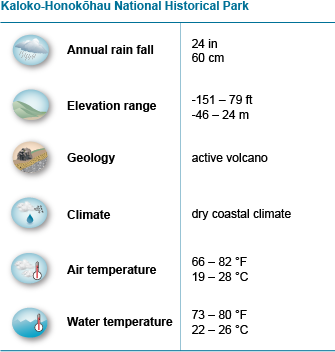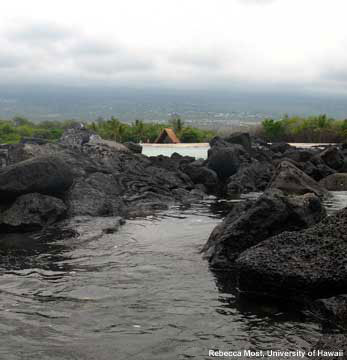The coral reefs and natural bays have both ecologically and culturally important features
Early Hawaiians used the coral reefs and natural bays of Kaloko-Honokōhau National Historical Park on the western shore of Hawai’i island for fishing and aquaculture. Today, the park maintains cultural treasures such as two fishponds and a fish trap used by ancient Hawaiians. The fishponds and surrounding coral reefs are home to many species of desired food fish such as Ê»ama'ama (mullet) and Ê»opelu (mackerel). Coral reef communities and the beaches in this park are also important habitat for honu (green sea turtles) and schools of brightly colored lau’i pala (yellow tangs). Due to this park’s proximity to an urban environment, a swimmer is almost as likely to see people as she is to see fish.Herbivorous fish, invertebrates, and honu protect corals from over-growth of algae
 Number of units: 1
Number of units: 1
Total area: 1,160 acres
Total marine area in park: 627 acres
Geological features allow fresh groundwater to seep into the coastal waters of the park. The places where the ocean water and freshwater meet make good habitat for soft corals (2% cover) that tend to thrive in less salty water.
Cover refers to the space covered by a particular organism on a reef or seafloor when viewed from above. Scientists often use changes in coral cover over time to monitor the overall health of a coral reef.
Rainfall and geology in this region determine how much freshwater reaches coral reefs at Kaloko-HonokÅhau National Historical Park through groundwater seeps. The groundwater influences water temperature, salinity, and nutrient levels—factors that affect coral reef health. Cold groundwater seeps might reduce the impacts of climate change on coral reefs by counteracting increasing ocean temperatures on a small localized scale.



